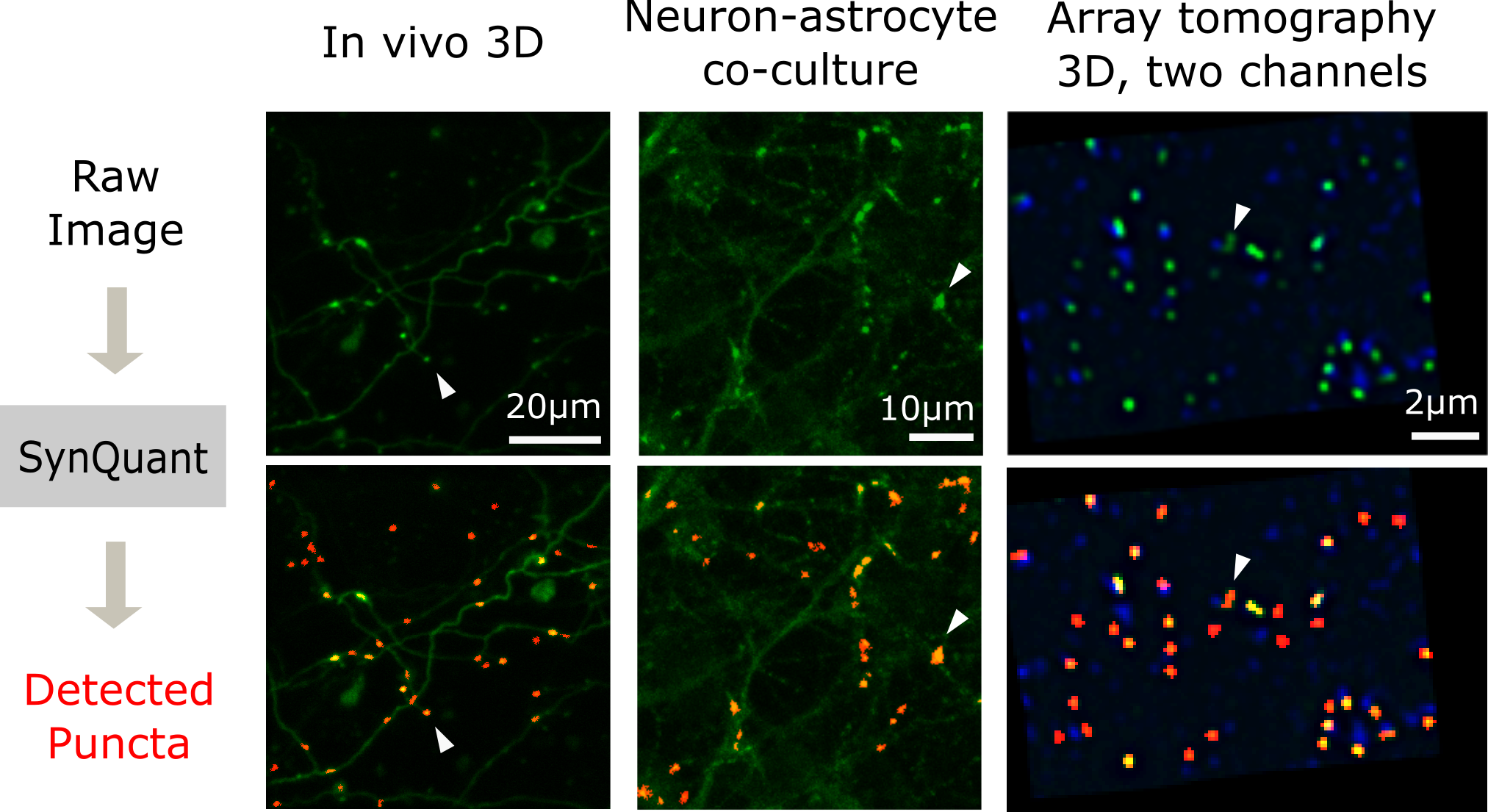SynQuant is a Fiji plugin that automatically quantify synapses from fluorescence microscopy images. If you have any feedback or issue, you are welcome to either post issue in Issues section or send email to yug@vt.edu (Guoqiang Yu at Virginia Tech).
- Welcome to SynQuant
- Why SynQuant
- Getting started
- Images and datasets
- Algorithm overview
- Updates
- Reference
SynQuant is a Fiji plugin that automatically quantify synapses from fluorescence microscopy images. Try SynQuant Now!
Any problem? SynQuant does not work on your data? Please open an issue. We are happy to help!
- Detect and segment synaptic punctum
- 2D and 3D data
- Confocal imaging, two-photon imaging, and array tomograhy
- Cultured tissue, brain slice, and in-vivo data
- Combine pre-synaptic and post-synaptic chanenls to predict the ground-truth synaptic cleft
- With or without neurite comtamination
- Puncta may have different sizes, shapes and brighness
- SynQuant performs better than peer unsupervised methods [5-8] for all the three data sets we tested (3D in-vivo [2], array tomography [3], neuron-astrocyte coculture [4]).
- SynQuant is performs similar with the best performing supervised method [10] in terms of F1 score and works better than it in terms of average precision.
- SynQuant outperforms other supervised methods [9,11].
- SynQuant is based on order statistics, which assign a p-value or z-score to each puncta.
- Adjust z-score to trade-off between false positives and false negatives.
- User friendly Fiji plug-in
- Export detected puncta to ROI manager
- For 2D image, SynQuant can trace neurites as well
- Coming soon: Have lots of images? It is easy to to call the Java class of SynQuant in your MATLAB code.
- Downlaod SynQuant.
- If you do not have Fiji yet, get it here.
- Put the downloaded jar file to the
pluginfolder of Fiji. - Open Fiji and load the image.
- Open
SynQuantVidfrom thepluginsmenu. - Check out the user guide.
- Check out the Simple Video Demo.
Example data for testing SynQuant plugin can be found here.
Click here to get the following things related to the experiments in [1]:
- Three real data sets and labels
- Synthetic data with labels
- Description of real and synthetic data
- Code to generate synthetic data
SynQuant detect synapses through an unsupervised probability principled framework. In this framework, analysis is conducted on salient regions rather than pixels.
All synapse candidates are scored by order statistics which combine the information of size, local contrast and noise level. What’s more, p-value or z-score to determine synapse selection, which provides a statistical evidence of the detected synapse. The parameter used in this framework is only the threshold of p-value or z-score which is statistically meaningful and easy to tune.
The framework of synapse detection algorithm now is based on the idea of component tree which scales well to 3D data.
For more information, check out our paper. For citation, see reference [1].
Version 1.2.8 [7/30/2020]
- Fixed the bug that SynQuant can’t get any result when the input images don’t contain any noise.
Version 1.2.7 [7/3/2020]
- When users open SynQuant without any valid image, it will give users a notification..
Version 1.2.6 [6/11/2020]
- Add extending distance for the "intersect" channel combination method.
Version 1.2
- Allow for the detection of pre-, post-synaptic puncta and synaptic sites.
- Add the function of combining pre-, post-synaptic puncta detection results.
- Support of puncta detection for both 2D and 3D data in the same plugin.
- Add one more noise estimation/stabilization method.
- Add two more input parameters for user to tune their targets' shapes.
- Add a slider for user to post-process results based on z-score.
Version 1.1
- Add the component tree structure for synapse detection suggested by Dr.Petter Ranefall. 3 times faster than before
- Output ROI regions overlaid with original synaptic data. Quantification can be done based on detected synapses or synaptic sites.
[1] Yizhi Wang*, Congchao Wang*, Petter Ranefall, Gerard Joey Broussard, Yinxue Wang, Guilai Shi, Boyu Lyu, Chiung-Ting Wu, Yue Wang, Lin Tian, Guoqiang Yu. (2020). SynQuant: An Automatic Tool to Quantify Synapses from Microscopy Images, Bioinformatics, 36(5), 1599–1606
[2] Bass, C., Helkkula, P., De Paola, V., Clopath, C., & Bharath, A. A. (2017). Detection of axonal synapses in 3d two-photon images. PloS one, 12(9).
[3] Collman, F., Buchanan, J., Phend, K. D., Micheva, K. D., Weinberg, R. J., & Smith, S. J. (2015). Mapping synapses by conjugate light-electron array tomography. Journal of Neuroscience, 35(14), 5792-5807.
[4] Mizuno, G. O., Wang, Y., Shi, G., Wang, Y., Sun, J., Papadopoulos, S., ... & Bhattacharyya, A. (2018). Aberrant calcium signaling in astrocytes inhibits neuronal excitability in a human Down syndrome stem cell model. Cell reports, 24(2), 355-365.
[5] Zhang, B., et al. (2007) Multiscale variance-stabilizing transform for mixed-Poisson-Gaussian processes and its applications in bioimaging. Image Processing, 2007 IEEE International Conference on, VI-233-VI-236.
[6] Rezatofighi, S., et al. (2012) A new approach for spot detection in total internal reflection fluorescence microscopy. Biomedical Imaging (ISBI), 2012 9th IEEE International Symposium on, 860-863.
[7] Schmitz, S., et al. "Automated analysis of neuronal morphology, synapse number and synaptic recruitment." Journal of neuroscience methods 195 (2011): 185-193.
[8] Simhal, AK., et al. "Probabilistic fluorescence-based synapse detection." PLoS computational biology 13.4 (2017).
[9] Bass, C., Helkkula, P., De Paola, V., Clopath, C., & Bharath, A. A. (2017). Detection of axonal synapses in 3d two-photon images. PloS one, 12(9).
[10] Kulikov, V., Guo, S. M., Stone, M., Goodman, A., Carpenter, A., Bathe, M., & Lempitsky, V. (2019). DoGNet: A deep architecture for synapse detection in multiplexed fluorescence images. PLoS computational biology, 15 (5).
[11] Ronneberger, O., et al. "U-net: Convolutional networks for biomedical image segmentation." International Conference on Medical image computing and computer-assisted intervention. Springer, Cham, 2015.


